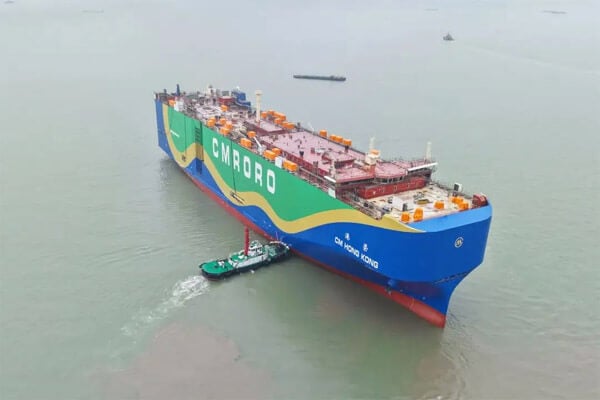China Puts Largest Car Carrier into Service, Launches First Methanol PCTC

China’s shipping industry continues to expand the car carrier sector as its export car market continues to grow. In one week, China has put the world’s largest car carrier, with a capacity for 9,500 units, into service and now has launched the world’s first methanol dual-fuel car carrier.
The Anji Ansheg departed Lianyungang, China on May 15 and with that became the largest car carrier yet placed into service. The vessel built for the state-owned SAIC Motors is the latest step for the company which is already the largest vehicle exporter from China.
The company which started exporting cars in 2001 skyrocketed to the leadership position by focusing on mid-range vehicles and now the growing market for EVs. In 2023 it reported exporting 1.21 million units, the third year in a row above 1 million units per year and bringing its export total to more than 5.5 million units. For eight consecutive years, SAIC has been the largest car exporter in China focusing on SUVs, sedans, MPVs, and pickup trucks in the international market.
To break through what the Chinese media refers to as a bottleneck of export capacity, SAIC launched SAIC Anji Logistics and started building its fleet of car carriers. With the introduction of the Anji Ansheng last week, the company reports it now has a total of 35 ships. This includes 15 ships in international trade, which will be increased to 22 in 2026, as well as nine ships in the domestic trade and 11 ships for river transport. The overseas ships are used to export cars primarily to Western Europe, Mexico, Southeast Asia, and the Middle East. The new ship currently bound for Bristol in the UK.
The new ship was built by China Merchants and is 228 meters (748 feet) in length. While it was built ready to use methanol as its primary fuel source, the honor of the first car carrier that will use methanol is going to the CM Hong Kong which was launched on May 21. The new vessel, also built by China Merchants Industry Group, is slightly smaller at 220 meters (721 feet) with a capacity for 9,300 cars. It will be operated by China Merchants Shipping as the first of two methanol-fueled vehicle (PCTC) carriers.
China Merchants highlights that Anji Ansheng employs energy-saving technologies and intelligent low-carbon systems. The CM Hong Kong, which is expected to be delivered in the second half of 2025, however, was outfitted with a complete methanol power plant. The main engine as well as the auxiliary engine and boiler are all designed to use methanol.

CM Hong Kong launched this week is the first methanol dual-fuel car carrier (China Merchants)
The new ships follow the SAIC’s January 2024 introduction of the then largest Chinese dual-fuel vehicle carrier, SAIC Ajin Sincerity (18,200 dwt), which is powered by LNG. The vessel which is 200 meters (656 feet) in length has a capacity for 7,600 units.
The Chinese car companies are competing to expand their car carrier business. Rival BYD put its first car carrier BYD Explorer No. 1 into service in 2024 with a capacity of 5,000 units which is also LNG fueled. Last month, BYD put its newest vessel BYD Shenzhen (25,376 dwt) into service with a capacity of 9,200 units only to be eclipsed by SAIC’s new ship. Chinese officials pointed to these vessels as a demonstration of the strong demand for their car market.
The title of the largest car carrier however will move back to Europe in 2027. Hoegh in 2024 introduced the 9,100-unit Hoegh Aurora (25,563 dwt) but last year Norway’s Wallenius Wilhelmsen reported it would be upsizing eight of its new class of ships on order to be built in China. The eight ships in its new Shaper class will each have a capacity of 11,300 units. Hoegh, however, will be the fuel pioneer having received EU funding to make its newest vessel ammonia dual-fuel car carriers. It expects to take delivery on the first ammonia-fueled Aurora class vessel in 2027.
